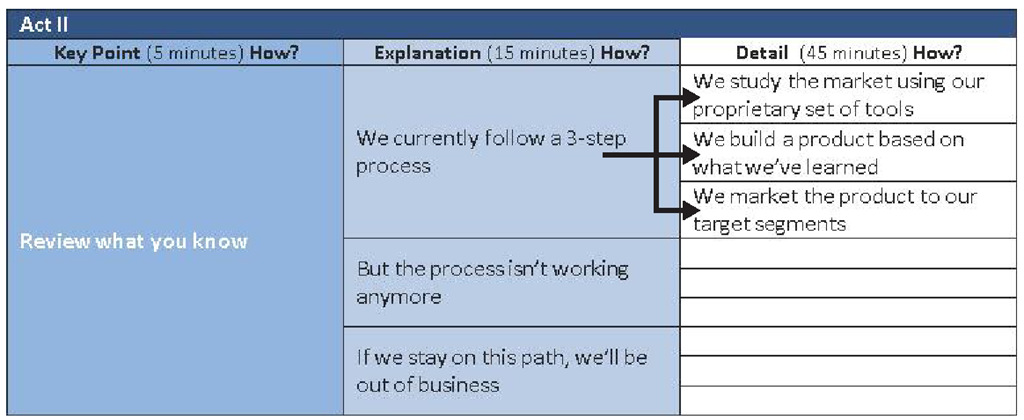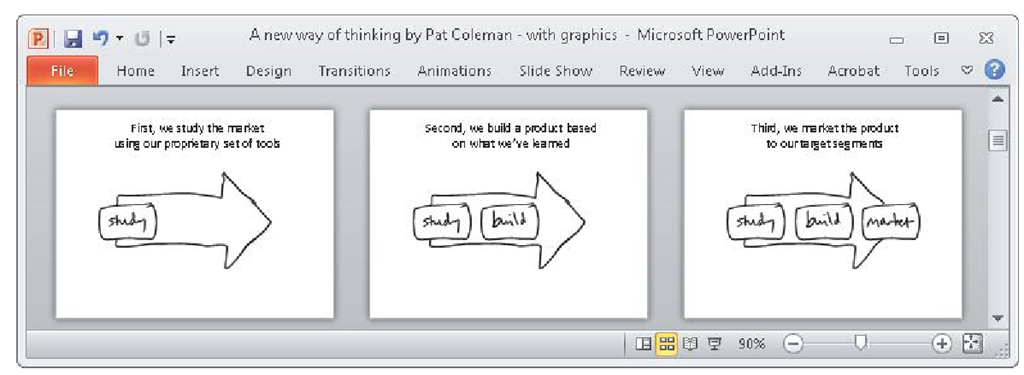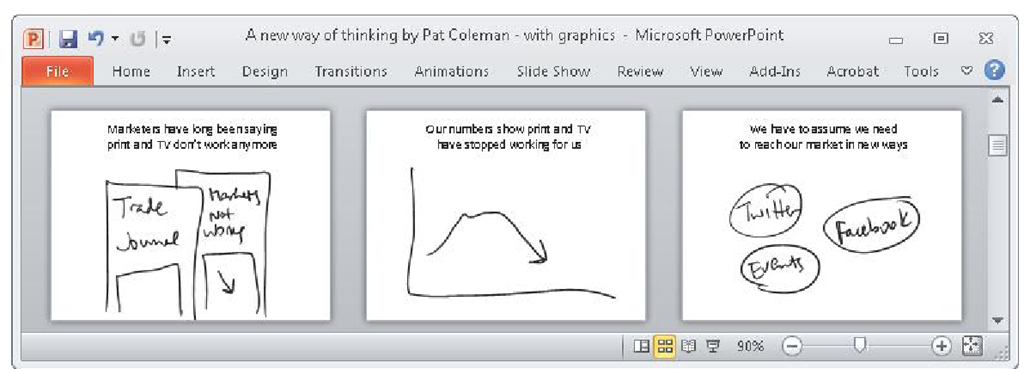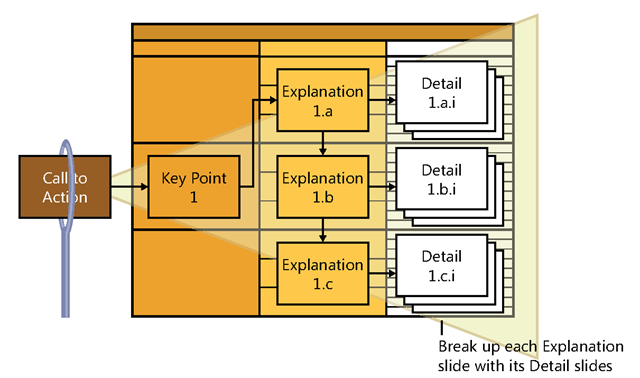The Explanation Headlines Test
Test the three Explanation headlines by filling in the blanks in this sentence:
The three main reasons/ways (insert Key Point headline) are (insert Explanation column, answer 1), (insert Explanation column, answer 2), and (insert Explanation column, answer 3).
When you have written your Explanation headlines, you have made sure that you will clarify each Key Point slide with the Explanation slides that follow it. The Explanation slides form the middle of the slide hierarchy, as shown in Figure 5-15, which presents the second-most important informational pieces to working memory—the sub-parts of your Key Point headlines.
FIGURE 5-15 The middle of your slide hierarchy consists of your second-most important slides—the Explanation slides. In an indented sentence outline, these slides correspond to outline items 1.a.,1.b., and 1.c.
Backing Up Each Explanation Headline with Its Detail Headlines
Now that you’ve written the headlines for your Key Point and Explanation slides, the last step is to back up each Explanation headline by writing headlines for its Detail slides. Fill in the Detail column using the same techniques you used for the Explanation column. Position your cursor to the right of the Detail column heading, and type the question (why or how) your audience will want to know next about your Explanation headlines—in this case, How? The questions you choose for your column headings will vary according to your topic, and sometimes they might be all why, all how, or combinations of the two. Now read each headline in the Explanation column, and ask why or how that headline is true. In this example, you’ll be asking the question how, as in: "How do we currently follow a three-step process?"
As you did in the Key Point and Explanation columns, type your three answers in the three cells of the Detail column in descending order of importance—the cells will expand to hold your text. Keep your headlines limited to about two and a half lines, as you did in the other two columns. The answers you enter in the Detail column should offer more detailed support for the Explanation headline and cite specific evidence that backs it up, as shown in Figure 5-16. This is where you include quantitative information, case studies, charts, graphs, anecdotes, analysis, and any other details that support the Explanation headline in the column to the left.
FIGURE 5-16 Testing the three Detail headlines to make sure they back up the Explanation headline to the left.
As with the Key Point and Explanation headlines, think of the way you will end up presenting these headlines visually in a sequence of slides, as shown in Figure 5-17. As before, you are breaking up the previous column’s headline into smaller pieces that you will present visually and verbally across slides. Whatever specific wording you choose for each Detail headline, you will back it up by the appropriate type of visual evidence, whether it is a screen capture, chart, graph, photograph, diagram, or other illustration. And just as you did in the previous columns, organize your headlines in a wide range of formats, including chronological, before-and-after results, 1-2-3 lists, and more.
FIGURE 5-17 Keep in mind how your Detail headlines will become the foundation for a visual story you tell across the corresponding slides in the storyboard.
After you’ve entered three answers in the Detail column, test them by filling in the blanks in this sentence:
The three main reasons/ways (insert Explanation column headline) are (insert Detail column, answer 1), (insert Detail column, answer 2), and (insert Detail column, answer 3).
In this example, the test headline would read as follows:
The three main ways we currently follow a three-step process are we study the market using our proprietary set of tools, we build a product based on what we’ve learned, and we market the product to our target segments
After you test your Detail column answers, go to the second Explanation headline and repeat this process for its corresponding Detail headlines. Then go to the third Explanation headline and repeat the process for its Detail headlines. When you’ve finished, you will have completed Act II, Scene 1, of your story template, as shown in Figure 5-18.
|
Key Point (5 minutes) How? |
Explanation (15 minutes) How? |
Detail (45 minutes) How? |
|
We currently follow a 3-step process |
We study the market using our proprietary set of tools |
|
|
We build a product based on what we’ve learned |
||
|
We market the product to our target segments |
||
|
Reviewwhat you know |
But the process isn’t working anymore |
Salesdropped Iastquarter |
|
Our research shows our products stayed on the shelf longer |
||
|
We weren’t able to reach our market through traditional channels |
||
|
Ifwe stayon this path, we’ll be out of business |
This is a red flag moment |
|
|
The trend is worrisome asyou Iookatit overtime |
||
|
Ifwestayon this track, we’ll be in the red by the fourth quarter ofnextyear |
||
FIGURE 5-18 Act II, Scene 1, of the sample story template, with all cells completed.
THE DETAIL HEADLINES TEST
Test the three Detail headlines by filling in the blanks in this sentence:
The three main reasons/ways (insert Explanation headline) are (insert Detail column, answer 1), (insert Detail column, answer 2), and (insert Detail column, answer 3).
As always, it is helpful to think of how your headlines will play out across the slides of your storyboard. In Figure 5-19, the Detail headlines tell the story of the second Explanation headline in the form of an anecdote told chronologically across the three slides.
FIGURE 5-19 Sketches showing how the Detail headlines tell a chronological story.
In Figure 5-20, the Detail headlines play out differently, as sketches of charts and screen captures explain the third Explanation headline with a step-by-step sequence of details across the slides.
FIGURE 5-20 Sketches showing how the Detail headlines relate quantitative information across slides.
When you have written your Detail headlines, you have made sure that you will back up each Explanation slide with the Detail slides that follow it. This is the bottom of the hierarchy, as shown in Figure 5-21, which presents the third-most important informational pieces to working memory.
Now that you’ve finished writing the headlines for Act II, Scene 1, it’s time to move on to Scenes 2 and 3.
FIGURE 5-21 The bottom of your hierarchy consists of your third-most important slides—the Detail slides. In a classical indented outline, these slides correspond to outline items 1.a.i., 1.b.i., 1.c.i., and so on.
Fleshing Out the Rest of Act II
With Act II, Scene 1, complete, your final job is to write the headlines for the rest of the slides in Act II. You’ll do this by applying the same process to both Scene 2 and Scene 3. Continue to check your reasoning with test sentences at each level, and revise your story template headlines as needed to keep the test sentences clear and consistent.
Act II of the story template is structured using groups of three ideas to make your ideas easier for your audience to understand, but you might find that you don’t have exactly three supporting headlines to write at any level in the template. If you want to use only two headlines, simply leave the third cell blank. If you need to add a fourth cell to the Explanation or Detail column, position the cursor in a cell, right-click, and select Insert Row—if the extra row creates extra cells in the Key Point and Explanation columns, merge the new cells into adjacent cells within the column. If you need to create four Key Point headlines, see "Tip 2: Make Room for Four," later in this topic. If you have more than four Key Point headlines, find a way to reduce that number, either by reworking your ideas or by merging several ideas into one main headline.
If you are having difficulty completing any point of the story template, try tackling it from a different direction. This topic followed a process of completing Act II working from the top of the hierarchy to the bottom (from left to right in the story template), which you may choose to do if you know your topic well. If you’re not completely sure of your message or your Key Point headlines, start first from the Detail column on the right, and work left through the Explanation column and finally the Key Point column.
When you complete the three scenes of Act II, your story template will likely extend across more than one page. In the completed Act II section of this story template, shown in Figure 5-22, the Detail column headlines have been abbreviated to display the three scenes on a single page.
|
|
|
|
|
Key Point (5 minutes) How? |
Explanation i’15 mi nutes) How? |
Detail (45 minutes) How? |
|
We currently foil ow a 3-step process |
We study the market using… |
|
|
We build a product based on … |
||
|
We market the product to… |
||
|
Butthe process isn’tworking anymore |
Salesdropped Iastquarter |
|
|
Our research shows our products |
||
|
We weren’t able to reach our… |
||
|
Ifwe stay on this path, we’ll be out of business |
This is a red flagmoment |
|
|
The trend is worrisome as… |
||
|
Ifwe stay on this track, we’ll… |
||
|
Step outside your assumptions |
Assume the market isn’t stable |
Our marketi ng consultants… |
|
The trends showthiswill… |
||
|
We have to assumethat… |
||
|
Assume products have shorter lives |
The average Iifeofaproduct… |
|
|
Research confirms consumer… |
||
|
We have to assume products… |
||
|
Assume marketing isn’tworking anymore |
Marketers have long been … |
|
|
Our numbers show print and… |
||
|
We have to assumewe need … |
||
|
Step back inside a new way of thinking |
Reconsiderwhat a market is |
The fixed market is givingway… |
|
Several market leaders have … Insteadoffixed markets, think… |
||
|
Reconsiderwhat a product is |
Productsare one-time efforts… |
|
|
Several of our competitors… |
||
|
Insteadof a fini shed product… |
||
|
Reconsiderwhatmarketing is |
Social media has opened up … |
|
|
Our competitors have had… |
||
|
Insteadof 1-way media buys… |
||
FIGURE 5-22 Act II of the sample story template, with all three scenes completed.
Each idea you introduce in the presentation will prompt your audience to wonder, "Why or how is this true?" Because each column in your story template is set up to answer the question why or how, you provide immediate answers. In story terms, this creates a steady dynamic of action/reaction—one column is an "action," and the next column is a "reaction" to it. This dynamic structure in Act II helps you to examine all the possible directions for your story. It also helps you to align your information with the way people naturally think and reason, making your story more interesting and engaging.






